Organisational Behaviour Report: LG's Culture, Motivation, and Teams
VerifiedAdded on 2020/10/22
|9
|2695
|310
Report
AI Summary
This report provides an in-depth analysis of organisational behaviour principles as applied to LG Electronics. It begins by examining the influence of culture, politics, and power on employee behaviour, referencing Handy's model and Hofstede's cultural dimensions. The report then evaluates various motivation techniques, specifically focusing on Maslow's Hierarchy of Needs and how LG can apply it to enhance employee satisfaction and productivity. Furthermore, it explores different types of organisational teams within LG, including functional, problem-solving, and project teams, and discusses Tuckman's Team Development Model to improve cooperation. Finally, the report applies concepts from organisational behaviour, such as the Path-Goal theory of leadership, to address employee concerns about future growth within the company, offering insights into directive, achievement-oriented, participative, and supportive leadership styles to foster a positive and productive work environment. The report demonstrates a comprehensive understanding of organisational behaviour theories and their practical application in a real-world business context.
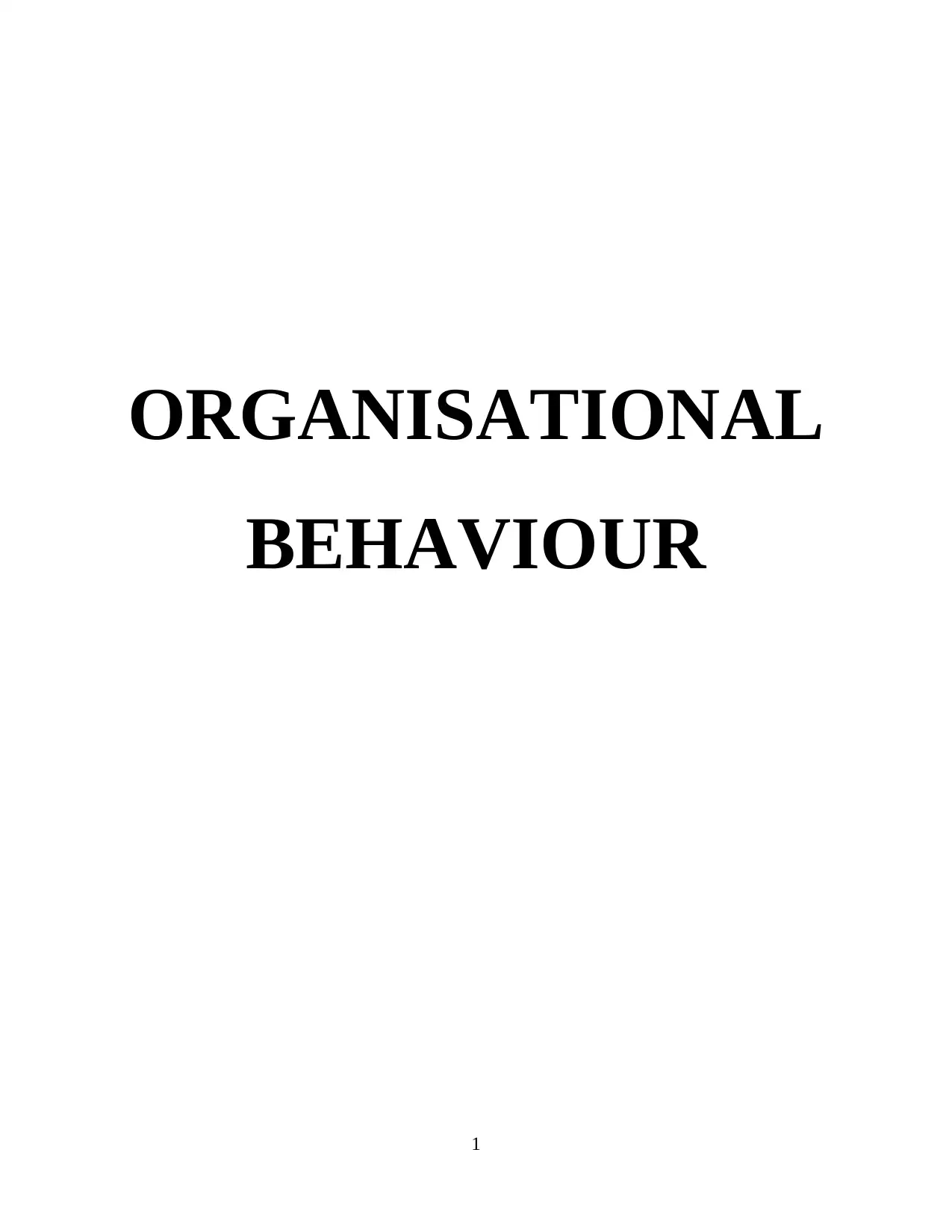
ORGANISATIONAL
BEHAVIOUR
1
BEHAVIOUR
1
Paraphrase This Document
Need a fresh take? Get an instant paraphrase of this document with our AI Paraphraser
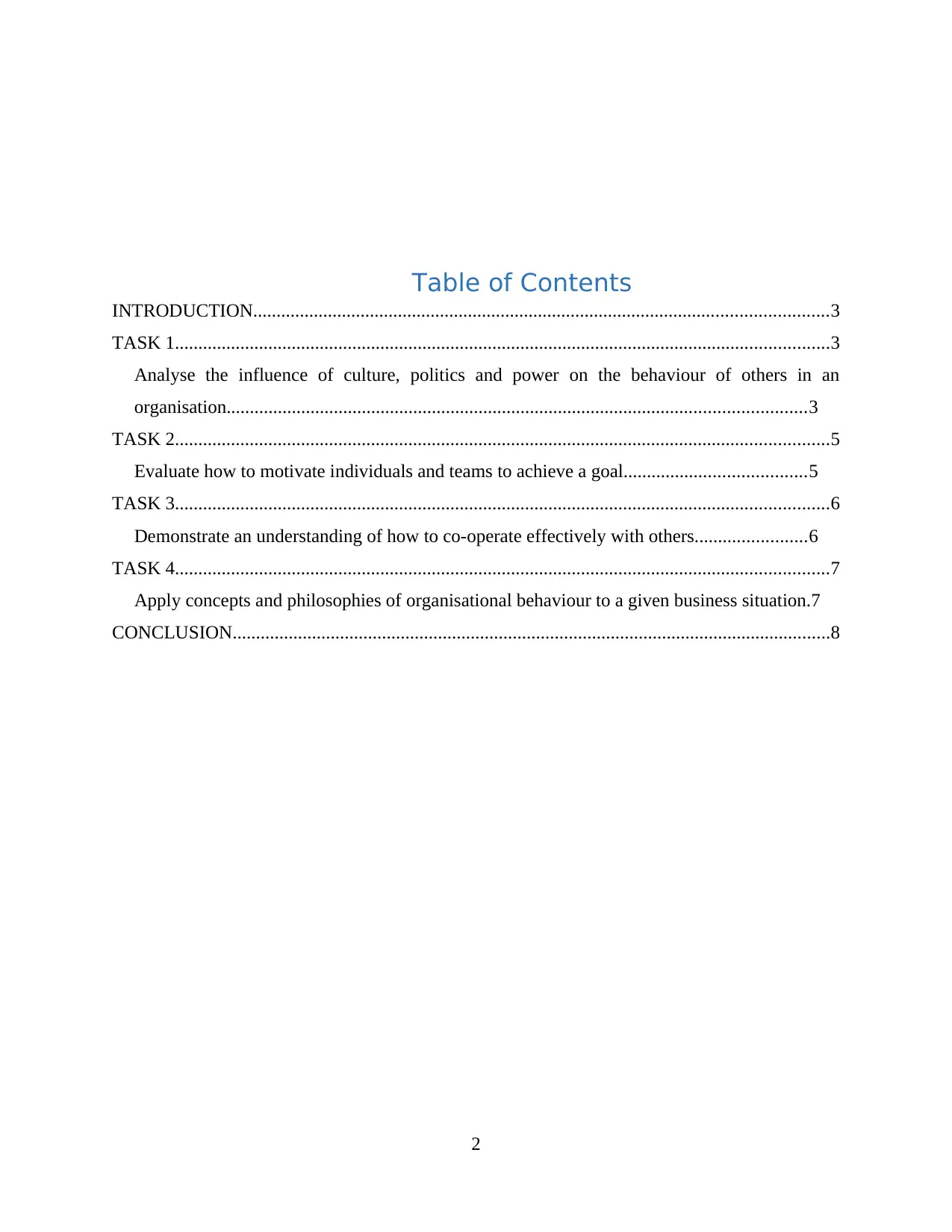
Table of Contents
INTRODUCTION...........................................................................................................................3
TASK 1............................................................................................................................................3
Analyse the influence of culture, politics and power on the behaviour of others in an
organisation............................................................................................................................3
TASK 2............................................................................................................................................5
Evaluate how to motivate individuals and teams to achieve a goal.......................................5
TASK 3............................................................................................................................................6
Demonstrate an understanding of how to co-operate effectively with others........................6
TASK 4............................................................................................................................................7
Apply concepts and philosophies of organisational behaviour to a given business situation.7
CONCLUSION................................................................................................................................8
2
INTRODUCTION...........................................................................................................................3
TASK 1............................................................................................................................................3
Analyse the influence of culture, politics and power on the behaviour of others in an
organisation............................................................................................................................3
TASK 2............................................................................................................................................5
Evaluate how to motivate individuals and teams to achieve a goal.......................................5
TASK 3............................................................................................................................................6
Demonstrate an understanding of how to co-operate effectively with others........................6
TASK 4............................................................................................................................................7
Apply concepts and philosophies of organisational behaviour to a given business situation.7
CONCLUSION................................................................................................................................8
2
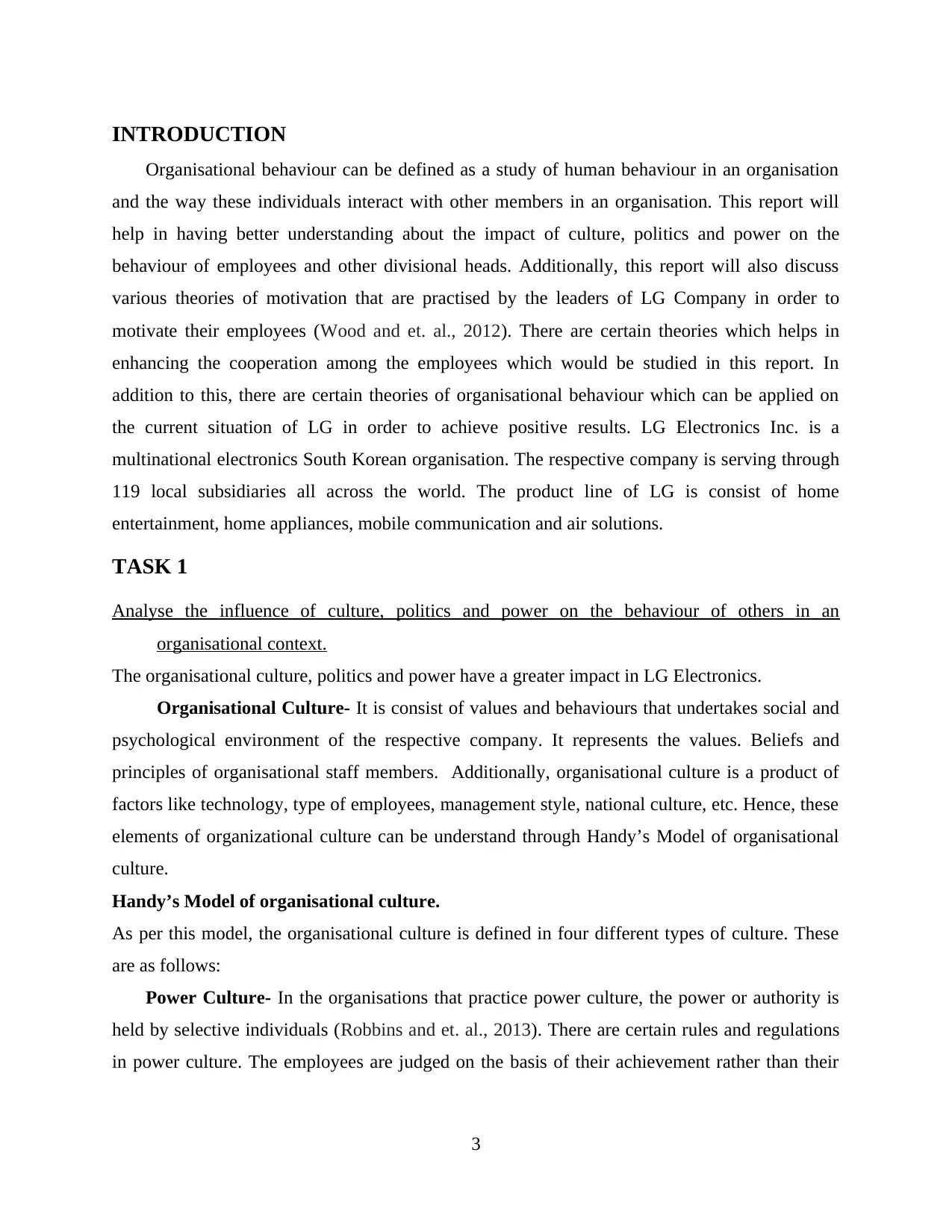
INTRODUCTION
Organisational behaviour can be defined as a study of human behaviour in an organisation
and the way these individuals interact with other members in an organisation. This report will
help in having better understanding about the impact of culture, politics and power on the
behaviour of employees and other divisional heads. Additionally, this report will also discuss
various theories of motivation that are practised by the leaders of LG Company in order to
motivate their employees (Wood and et. al., 2012). There are certain theories which helps in
enhancing the cooperation among the employees which would be studied in this report. In
addition to this, there are certain theories of organisational behaviour which can be applied on
the current situation of LG in order to achieve positive results. LG Electronics Inc. is a
multinational electronics South Korean organisation. The respective company is serving through
119 local subsidiaries all across the world. The product line of LG is consist of home
entertainment, home appliances, mobile communication and air solutions.
TASK 1
Analyse the influence of culture, politics and power on the behaviour of others in an
organisational context.
The organisational culture, politics and power have a greater impact in LG Electronics.
Organisational Culture- It is consist of values and behaviours that undertakes social and
psychological environment of the respective company. It represents the values. Beliefs and
principles of organisational staff members. Additionally, organisational culture is a product of
factors like technology, type of employees, management style, national culture, etc. Hence, these
elements of organizational culture can be understand through Handy’s Model of organisational
culture.
Handy’s Model of organisational culture.
As per this model, the organisational culture is defined in four different types of culture. These
are as follows:
Power Culture- In the organisations that practice power culture, the power or authority is
held by selective individuals (Robbins and et. al., 2013). There are certain rules and regulations
in power culture. The employees are judged on the basis of their achievement rather than their
3
Organisational behaviour can be defined as a study of human behaviour in an organisation
and the way these individuals interact with other members in an organisation. This report will
help in having better understanding about the impact of culture, politics and power on the
behaviour of employees and other divisional heads. Additionally, this report will also discuss
various theories of motivation that are practised by the leaders of LG Company in order to
motivate their employees (Wood and et. al., 2012). There are certain theories which helps in
enhancing the cooperation among the employees which would be studied in this report. In
addition to this, there are certain theories of organisational behaviour which can be applied on
the current situation of LG in order to achieve positive results. LG Electronics Inc. is a
multinational electronics South Korean organisation. The respective company is serving through
119 local subsidiaries all across the world. The product line of LG is consist of home
entertainment, home appliances, mobile communication and air solutions.
TASK 1
Analyse the influence of culture, politics and power on the behaviour of others in an
organisational context.
The organisational culture, politics and power have a greater impact in LG Electronics.
Organisational Culture- It is consist of values and behaviours that undertakes social and
psychological environment of the respective company. It represents the values. Beliefs and
principles of organisational staff members. Additionally, organisational culture is a product of
factors like technology, type of employees, management style, national culture, etc. Hence, these
elements of organizational culture can be understand through Handy’s Model of organisational
culture.
Handy’s Model of organisational culture.
As per this model, the organisational culture is defined in four different types of culture. These
are as follows:
Power Culture- In the organisations that practice power culture, the power or authority is
held by selective individuals (Robbins and et. al., 2013). There are certain rules and regulations
in power culture. The employees are judged on the basis of their achievement rather than their
3
⊘ This is a preview!⊘
Do you want full access?
Subscribe today to unlock all pages.

Trusted by 1+ million students worldwide
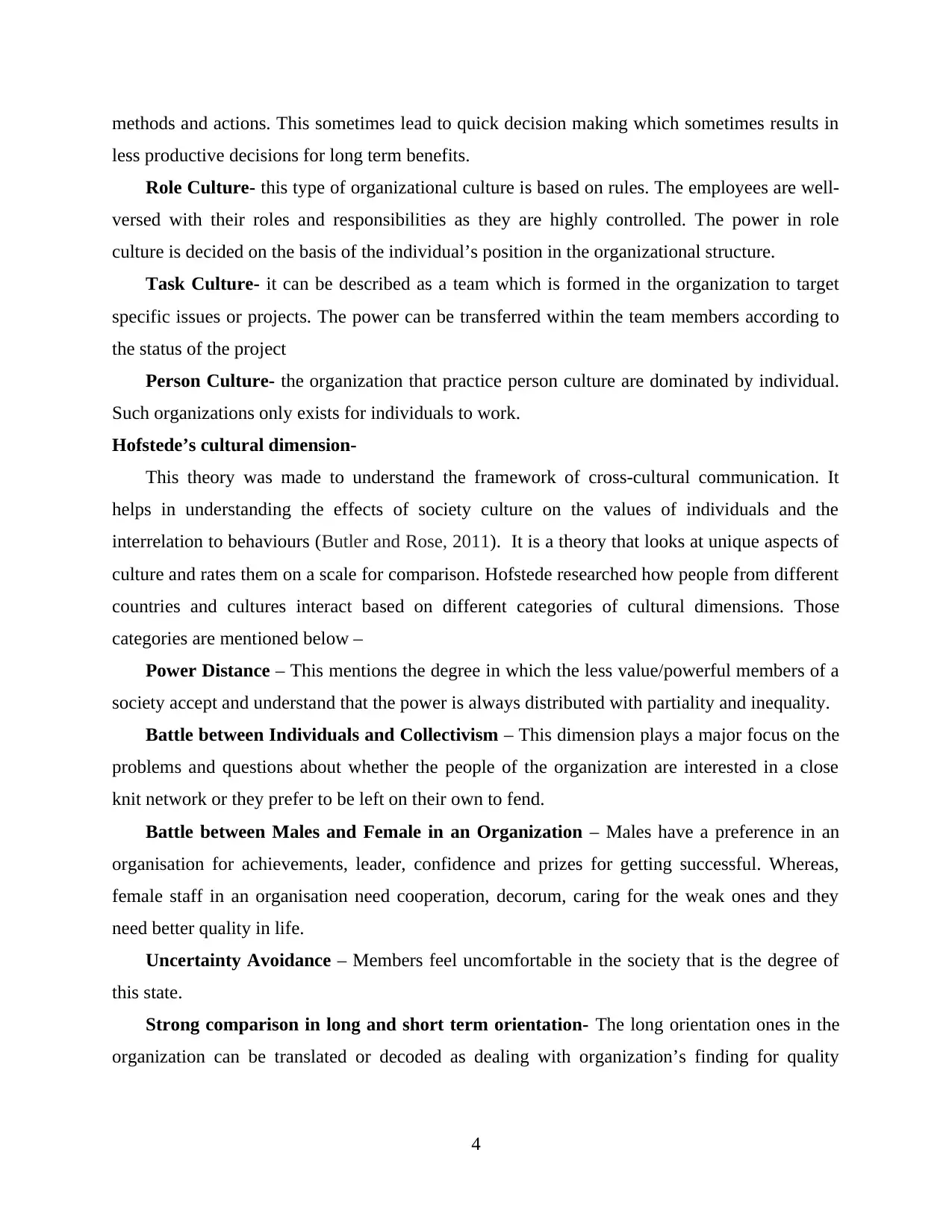
methods and actions. This sometimes lead to quick decision making which sometimes results in
less productive decisions for long term benefits.
Role Culture- this type of organizational culture is based on rules. The employees are well-
versed with their roles and responsibilities as they are highly controlled. The power in role
culture is decided on the basis of the individual’s position in the organizational structure.
Task Culture- it can be described as a team which is formed in the organization to target
specific issues or projects. The power can be transferred within the team members according to
the status of the project
Person Culture- the organization that practice person culture are dominated by individual.
Such organizations only exists for individuals to work.
Hofstede’s cultural dimension-
This theory was made to understand the framework of cross-cultural communication. It
helps in understanding the effects of society culture on the values of individuals and the
interrelation to behaviours (Butler and Rose, 2011). It is a theory that looks at unique aspects of
culture and rates them on a scale for comparison. Hofstede researched how people from different
countries and cultures interact based on different categories of cultural dimensions. Those
categories are mentioned below –
Power Distance – This mentions the degree in which the less value/powerful members of a
society accept and understand that the power is always distributed with partiality and inequality.
Battle between Individuals and Collectivism – This dimension plays a major focus on the
problems and questions about whether the people of the organization are interested in a close
knit network or they prefer to be left on their own to fend.
Battle between Males and Female in an Organization – Males have a preference in an
organisation for achievements, leader, confidence and prizes for getting successful. Whereas,
female staff in an organisation need cooperation, decorum, caring for the weak ones and they
need better quality in life.
Uncertainty Avoidance – Members feel uncomfortable in the society that is the degree of
this state.
Strong comparison in long and short term orientation- The long orientation ones in the
organization can be translated or decoded as dealing with organization’s finding for quality
4
less productive decisions for long term benefits.
Role Culture- this type of organizational culture is based on rules. The employees are well-
versed with their roles and responsibilities as they are highly controlled. The power in role
culture is decided on the basis of the individual’s position in the organizational structure.
Task Culture- it can be described as a team which is formed in the organization to target
specific issues or projects. The power can be transferred within the team members according to
the status of the project
Person Culture- the organization that practice person culture are dominated by individual.
Such organizations only exists for individuals to work.
Hofstede’s cultural dimension-
This theory was made to understand the framework of cross-cultural communication. It
helps in understanding the effects of society culture on the values of individuals and the
interrelation to behaviours (Butler and Rose, 2011). It is a theory that looks at unique aspects of
culture and rates them on a scale for comparison. Hofstede researched how people from different
countries and cultures interact based on different categories of cultural dimensions. Those
categories are mentioned below –
Power Distance – This mentions the degree in which the less value/powerful members of a
society accept and understand that the power is always distributed with partiality and inequality.
Battle between Individuals and Collectivism – This dimension plays a major focus on the
problems and questions about whether the people of the organization are interested in a close
knit network or they prefer to be left on their own to fend.
Battle between Males and Female in an Organization – Males have a preference in an
organisation for achievements, leader, confidence and prizes for getting successful. Whereas,
female staff in an organisation need cooperation, decorum, caring for the weak ones and they
need better quality in life.
Uncertainty Avoidance – Members feel uncomfortable in the society that is the degree of
this state.
Strong comparison in long and short term orientation- The long orientation ones in the
organization can be translated or decoded as dealing with organization’s finding for quality
4
Paraphrase This Document
Need a fresh take? Get an instant paraphrase of this document with our AI Paraphraser
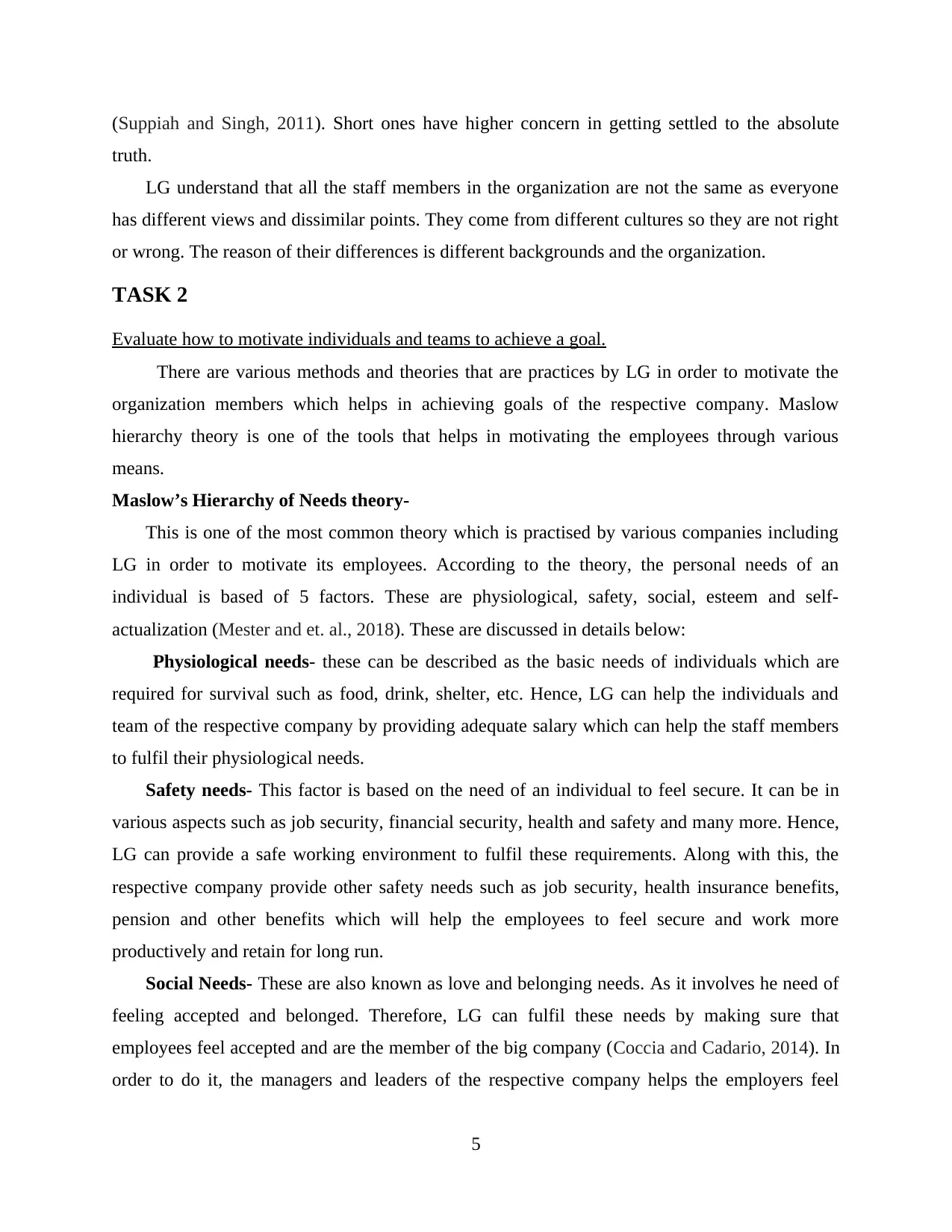
(Suppiah and Singh, 2011). Short ones have higher concern in getting settled to the absolute
truth.
LG understand that all the staff members in the organization are not the same as everyone
has different views and dissimilar points. They come from different cultures so they are not right
or wrong. The reason of their differences is different backgrounds and the organization.
TASK 2
Evaluate how to motivate individuals and teams to achieve a goal.
There are various methods and theories that are practices by LG in order to motivate the
organization members which helps in achieving goals of the respective company. Maslow
hierarchy theory is one of the tools that helps in motivating the employees through various
means.
Maslow’s Hierarchy of Needs theory-
This is one of the most common theory which is practised by various companies including
LG in order to motivate its employees. According to the theory, the personal needs of an
individual is based of 5 factors. These are physiological, safety, social, esteem and self-
actualization (Mester and et. al., 2018). These are discussed in details below:
Physiological needs- these can be described as the basic needs of individuals which are
required for survival such as food, drink, shelter, etc. Hence, LG can help the individuals and
team of the respective company by providing adequate salary which can help the staff members
to fulfil their physiological needs.
Safety needs- This factor is based on the need of an individual to feel secure. It can be in
various aspects such as job security, financial security, health and safety and many more. Hence,
LG can provide a safe working environment to fulfil these requirements. Along with this, the
respective company provide other safety needs such as job security, health insurance benefits,
pension and other benefits which will help the employees to feel secure and work more
productively and retain for long run.
Social Needs- These are also known as love and belonging needs. As it involves he need of
feeling accepted and belonged. Therefore, LG can fulfil these needs by making sure that
employees feel accepted and are the member of the big company (Coccia and Cadario, 2014). In
order to do it, the managers and leaders of the respective company helps the employers feel
5
truth.
LG understand that all the staff members in the organization are not the same as everyone
has different views and dissimilar points. They come from different cultures so they are not right
or wrong. The reason of their differences is different backgrounds and the organization.
TASK 2
Evaluate how to motivate individuals and teams to achieve a goal.
There are various methods and theories that are practices by LG in order to motivate the
organization members which helps in achieving goals of the respective company. Maslow
hierarchy theory is one of the tools that helps in motivating the employees through various
means.
Maslow’s Hierarchy of Needs theory-
This is one of the most common theory which is practised by various companies including
LG in order to motivate its employees. According to the theory, the personal needs of an
individual is based of 5 factors. These are physiological, safety, social, esteem and self-
actualization (Mester and et. al., 2018). These are discussed in details below:
Physiological needs- these can be described as the basic needs of individuals which are
required for survival such as food, drink, shelter, etc. Hence, LG can help the individuals and
team of the respective company by providing adequate salary which can help the staff members
to fulfil their physiological needs.
Safety needs- This factor is based on the need of an individual to feel secure. It can be in
various aspects such as job security, financial security, health and safety and many more. Hence,
LG can provide a safe working environment to fulfil these requirements. Along with this, the
respective company provide other safety needs such as job security, health insurance benefits,
pension and other benefits which will help the employees to feel secure and work more
productively and retain for long run.
Social Needs- These are also known as love and belonging needs. As it involves he need of
feeling accepted and belonged. Therefore, LG can fulfil these needs by making sure that
employees feel accepted and are the member of the big company (Coccia and Cadario, 2014). In
order to do it, the managers and leaders of the respective company helps the employers feel
5
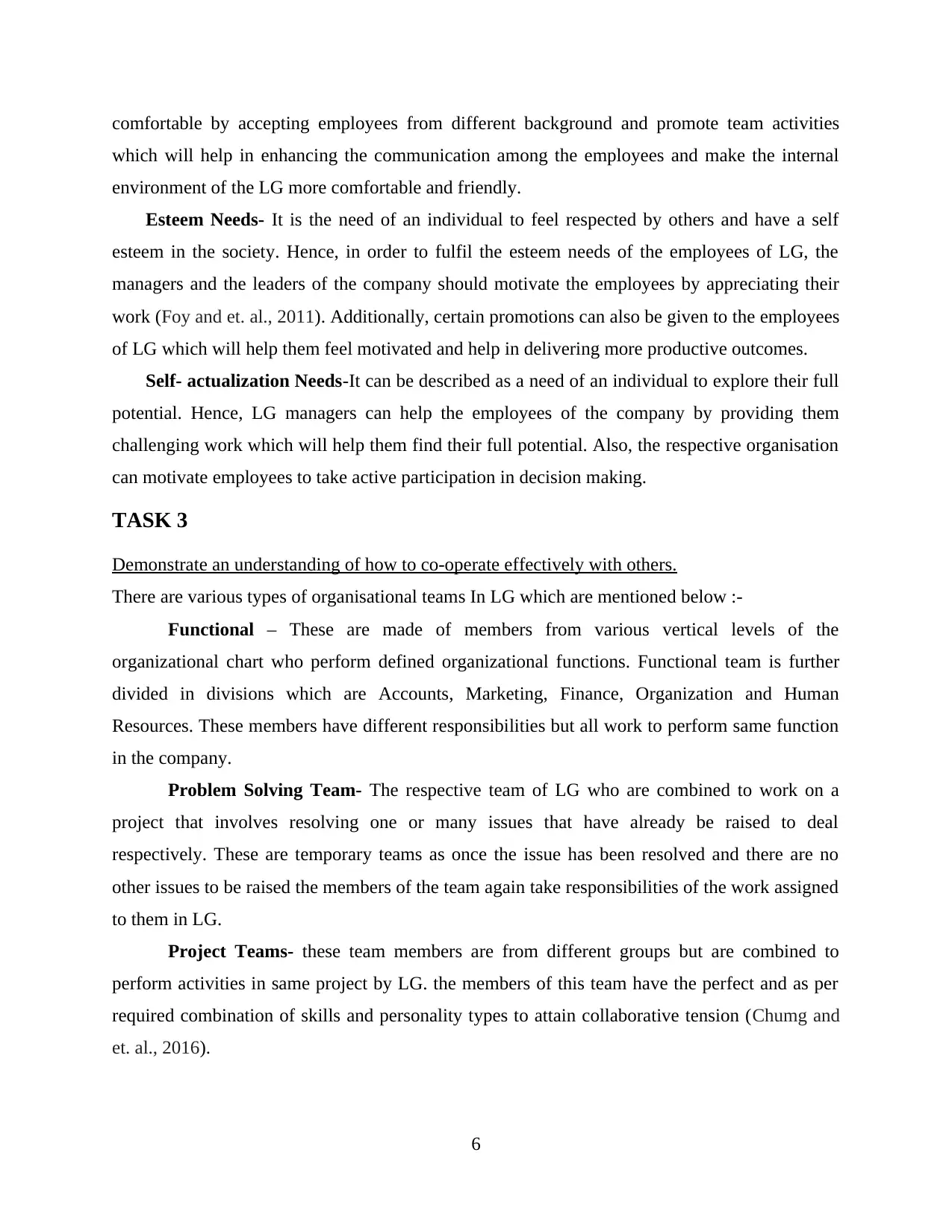
comfortable by accepting employees from different background and promote team activities
which will help in enhancing the communication among the employees and make the internal
environment of the LG more comfortable and friendly.
Esteem Needs- It is the need of an individual to feel respected by others and have a self
esteem in the society. Hence, in order to fulfil the esteem needs of the employees of LG, the
managers and the leaders of the company should motivate the employees by appreciating their
work (Foy and et. al., 2011). Additionally, certain promotions can also be given to the employees
of LG which will help them feel motivated and help in delivering more productive outcomes.
Self- actualization Needs-It can be described as a need of an individual to explore their full
potential. Hence, LG managers can help the employees of the company by providing them
challenging work which will help them find their full potential. Also, the respective organisation
can motivate employees to take active participation in decision making.
TASK 3
Demonstrate an understanding of how to co-operate effectively with others.
There are various types of organisational teams In LG which are mentioned below :-
Functional – These are made of members from various vertical levels of the
organizational chart who perform defined organizational functions. Functional team is further
divided in divisions which are Accounts, Marketing, Finance, Organization and Human
Resources. These members have different responsibilities but all work to perform same function
in the company.
Problem Solving Team- The respective team of LG who are combined to work on a
project that involves resolving one or many issues that have already be raised to deal
respectively. These are temporary teams as once the issue has been resolved and there are no
other issues to be raised the members of the team again take responsibilities of the work assigned
to them in LG.
Project Teams- these team members are from different groups but are combined to
perform activities in same project by LG. the members of this team have the perfect and as per
required combination of skills and personality types to attain collaborative tension (Chumg and
et. al., 2016).
6
which will help in enhancing the communication among the employees and make the internal
environment of the LG more comfortable and friendly.
Esteem Needs- It is the need of an individual to feel respected by others and have a self
esteem in the society. Hence, in order to fulfil the esteem needs of the employees of LG, the
managers and the leaders of the company should motivate the employees by appreciating their
work (Foy and et. al., 2011). Additionally, certain promotions can also be given to the employees
of LG which will help them feel motivated and help in delivering more productive outcomes.
Self- actualization Needs-It can be described as a need of an individual to explore their full
potential. Hence, LG managers can help the employees of the company by providing them
challenging work which will help them find their full potential. Also, the respective organisation
can motivate employees to take active participation in decision making.
TASK 3
Demonstrate an understanding of how to co-operate effectively with others.
There are various types of organisational teams In LG which are mentioned below :-
Functional – These are made of members from various vertical levels of the
organizational chart who perform defined organizational functions. Functional team is further
divided in divisions which are Accounts, Marketing, Finance, Organization and Human
Resources. These members have different responsibilities but all work to perform same function
in the company.
Problem Solving Team- The respective team of LG who are combined to work on a
project that involves resolving one or many issues that have already be raised to deal
respectively. These are temporary teams as once the issue has been resolved and there are no
other issues to be raised the members of the team again take responsibilities of the work assigned
to them in LG.
Project Teams- these team members are from different groups but are combined to
perform activities in same project by LG. the members of this team have the perfect and as per
required combination of skills and personality types to attain collaborative tension (Chumg and
et. al., 2016).
6
⊘ This is a preview!⊘
Do you want full access?
Subscribe today to unlock all pages.

Trusted by 1+ million students worldwide
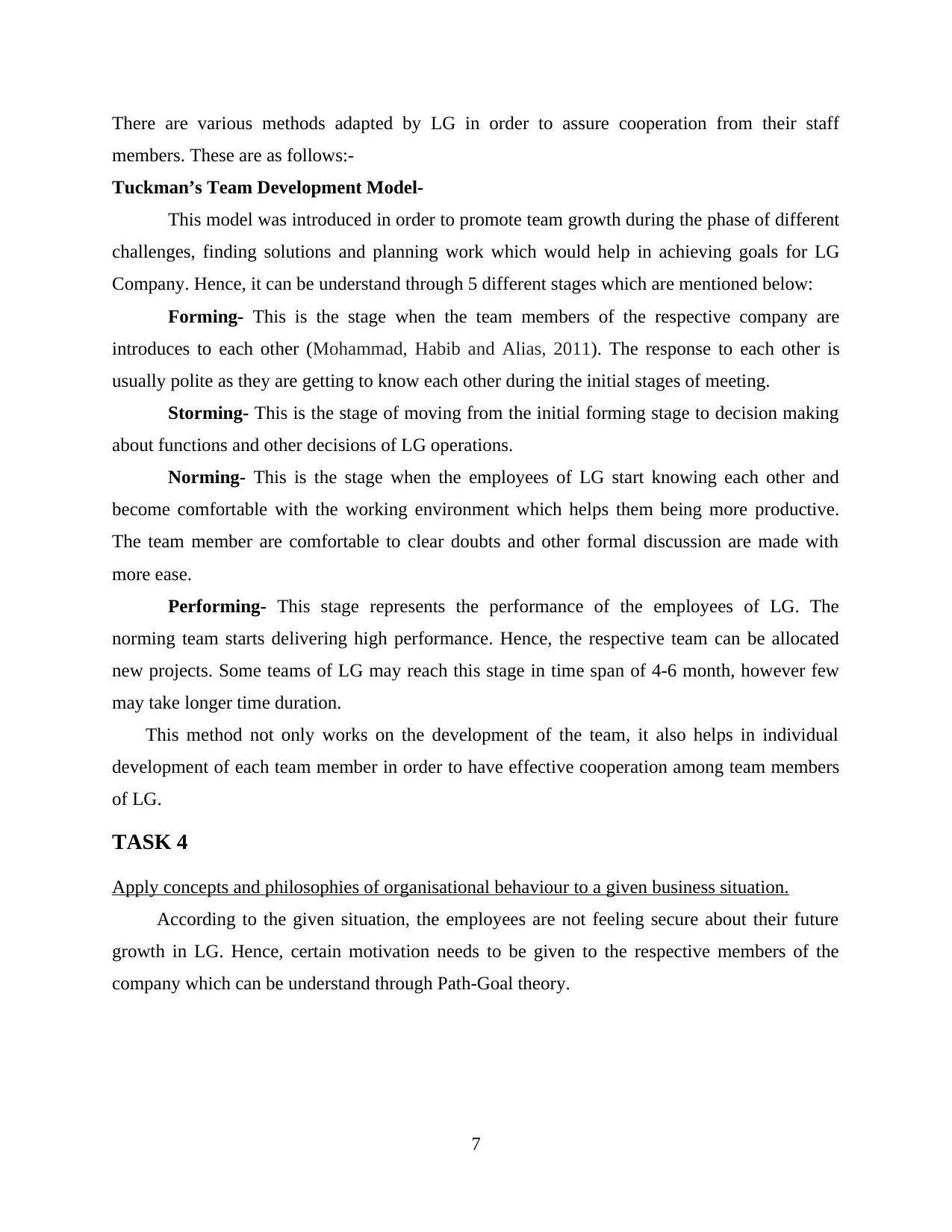
There are various methods adapted by LG in order to assure cooperation from their staff
members. These are as follows:-
Tuckman’s Team Development Model-
This model was introduced in order to promote team growth during the phase of different
challenges, finding solutions and planning work which would help in achieving goals for LG
Company. Hence, it can be understand through 5 different stages which are mentioned below:
Forming- This is the stage when the team members of the respective company are
introduces to each other (Mohammad, Habib and Alias, 2011). The response to each other is
usually polite as they are getting to know each other during the initial stages of meeting.
Storming- This is the stage of moving from the initial forming stage to decision making
about functions and other decisions of LG operations.
Norming- This is the stage when the employees of LG start knowing each other and
become comfortable with the working environment which helps them being more productive.
The team member are comfortable to clear doubts and other formal discussion are made with
more ease.
Performing- This stage represents the performance of the employees of LG. The
norming team starts delivering high performance. Hence, the respective team can be allocated
new projects. Some teams of LG may reach this stage in time span of 4-6 month, however few
may take longer time duration.
This method not only works on the development of the team, it also helps in individual
development of each team member in order to have effective cooperation among team members
of LG.
TASK 4
Apply concepts and philosophies of organisational behaviour to a given business situation.
According to the given situation, the employees are not feeling secure about their future
growth in LG. Hence, certain motivation needs to be given to the respective members of the
company which can be understand through Path-Goal theory.
7
members. These are as follows:-
Tuckman’s Team Development Model-
This model was introduced in order to promote team growth during the phase of different
challenges, finding solutions and planning work which would help in achieving goals for LG
Company. Hence, it can be understand through 5 different stages which are mentioned below:
Forming- This is the stage when the team members of the respective company are
introduces to each other (Mohammad, Habib and Alias, 2011). The response to each other is
usually polite as they are getting to know each other during the initial stages of meeting.
Storming- This is the stage of moving from the initial forming stage to decision making
about functions and other decisions of LG operations.
Norming- This is the stage when the employees of LG start knowing each other and
become comfortable with the working environment which helps them being more productive.
The team member are comfortable to clear doubts and other formal discussion are made with
more ease.
Performing- This stage represents the performance of the employees of LG. The
norming team starts delivering high performance. Hence, the respective team can be allocated
new projects. Some teams of LG may reach this stage in time span of 4-6 month, however few
may take longer time duration.
This method not only works on the development of the team, it also helps in individual
development of each team member in order to have effective cooperation among team members
of LG.
TASK 4
Apply concepts and philosophies of organisational behaviour to a given business situation.
According to the given situation, the employees are not feeling secure about their future
growth in LG. Hence, certain motivation needs to be given to the respective members of the
company which can be understand through Path-Goal theory.
7
Paraphrase This Document
Need a fresh take? Get an instant paraphrase of this document with our AI Paraphraser
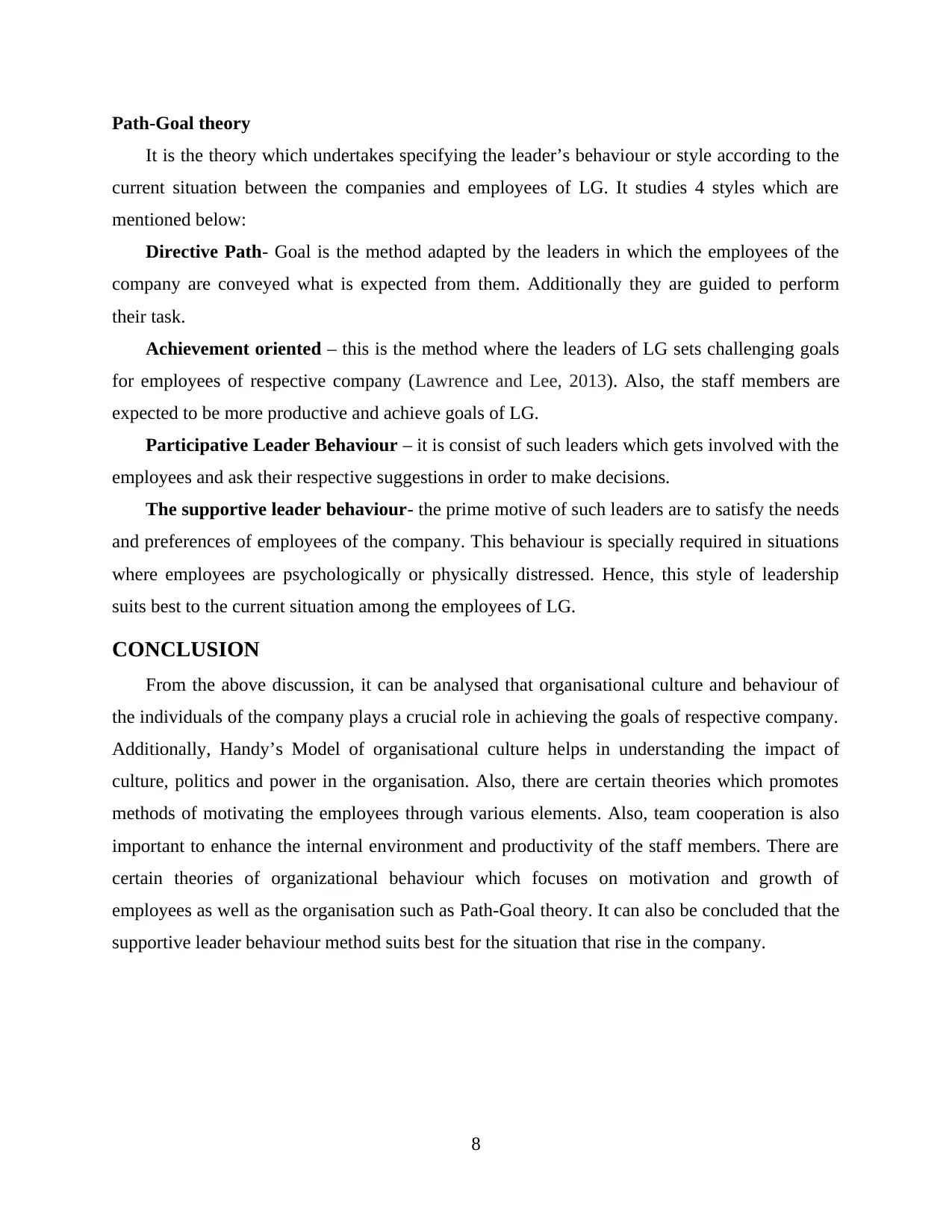
Path-Goal theory
It is the theory which undertakes specifying the leader’s behaviour or style according to the
current situation between the companies and employees of LG. It studies 4 styles which are
mentioned below:
Directive Path- Goal is the method adapted by the leaders in which the employees of the
company are conveyed what is expected from them. Additionally they are guided to perform
their task.
Achievement oriented – this is the method where the leaders of LG sets challenging goals
for employees of respective company (Lawrence and Lee, 2013). Also, the staff members are
expected to be more productive and achieve goals of LG.
Participative Leader Behaviour – it is consist of such leaders which gets involved with the
employees and ask their respective suggestions in order to make decisions.
The supportive leader behaviour- the prime motive of such leaders are to satisfy the needs
and preferences of employees of the company. This behaviour is specially required in situations
where employees are psychologically or physically distressed. Hence, this style of leadership
suits best to the current situation among the employees of LG.
CONCLUSION
From the above discussion, it can be analysed that organisational culture and behaviour of
the individuals of the company plays a crucial role in achieving the goals of respective company.
Additionally, Handy’s Model of organisational culture helps in understanding the impact of
culture, politics and power in the organisation. Also, there are certain theories which promotes
methods of motivating the employees through various elements. Also, team cooperation is also
important to enhance the internal environment and productivity of the staff members. There are
certain theories of organizational behaviour which focuses on motivation and growth of
employees as well as the organisation such as Path-Goal theory. It can also be concluded that the
supportive leader behaviour method suits best for the situation that rise in the company.
8
It is the theory which undertakes specifying the leader’s behaviour or style according to the
current situation between the companies and employees of LG. It studies 4 styles which are
mentioned below:
Directive Path- Goal is the method adapted by the leaders in which the employees of the
company are conveyed what is expected from them. Additionally they are guided to perform
their task.
Achievement oriented – this is the method where the leaders of LG sets challenging goals
for employees of respective company (Lawrence and Lee, 2013). Also, the staff members are
expected to be more productive and achieve goals of LG.
Participative Leader Behaviour – it is consist of such leaders which gets involved with the
employees and ask their respective suggestions in order to make decisions.
The supportive leader behaviour- the prime motive of such leaders are to satisfy the needs
and preferences of employees of the company. This behaviour is specially required in situations
where employees are psychologically or physically distressed. Hence, this style of leadership
suits best to the current situation among the employees of LG.
CONCLUSION
From the above discussion, it can be analysed that organisational culture and behaviour of
the individuals of the company plays a crucial role in achieving the goals of respective company.
Additionally, Handy’s Model of organisational culture helps in understanding the impact of
culture, politics and power in the organisation. Also, there are certain theories which promotes
methods of motivating the employees through various elements. Also, team cooperation is also
important to enhance the internal environment and productivity of the staff members. There are
certain theories of organizational behaviour which focuses on motivation and growth of
employees as well as the organisation such as Path-Goal theory. It can also be concluded that the
supportive leader behaviour method suits best for the situation that rise in the company.
8
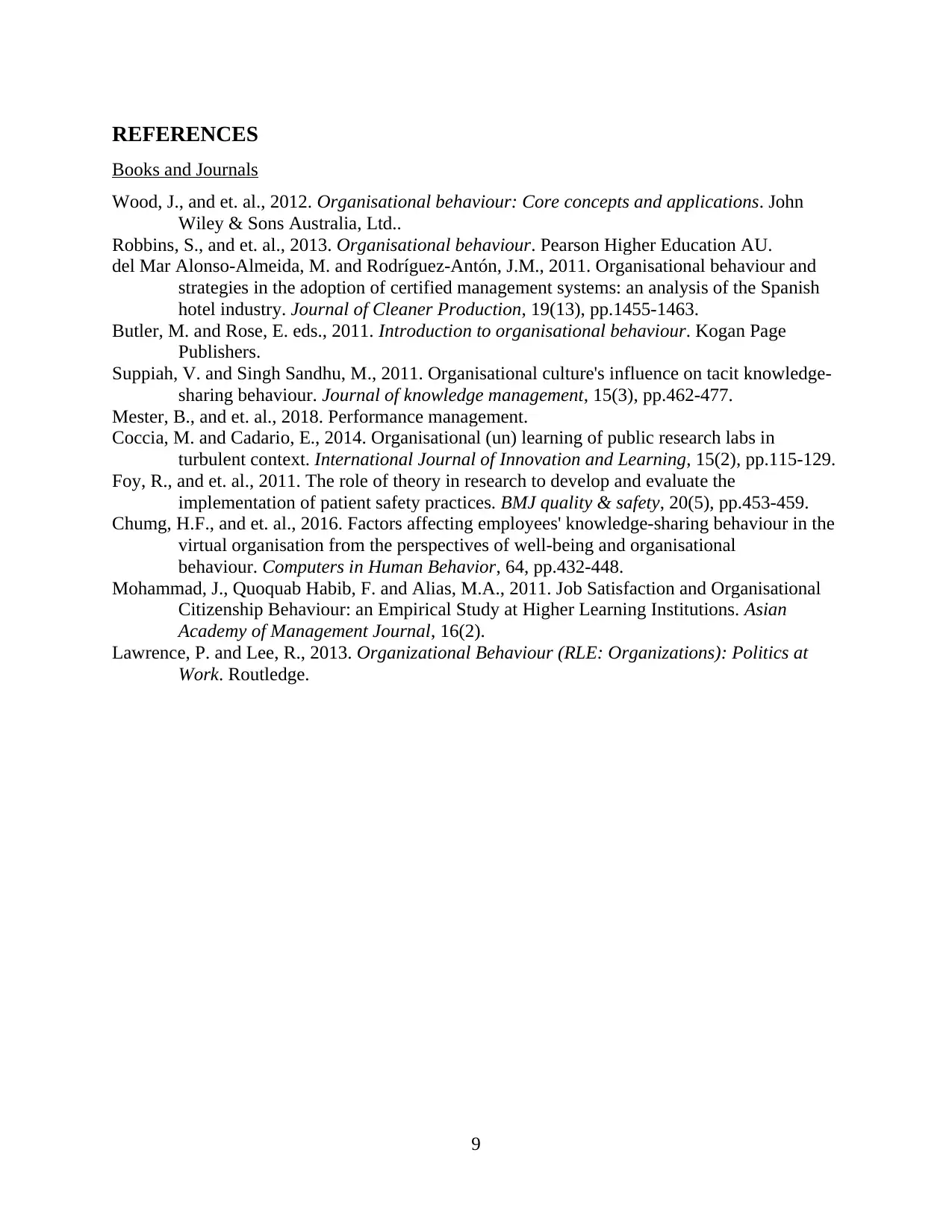
REFERENCES
Books and Journals
Wood, J., and et. al., 2012. Organisational behaviour: Core concepts and applications. John
Wiley & Sons Australia, Ltd..
Robbins, S., and et. al., 2013. Organisational behaviour. Pearson Higher Education AU.
del Mar Alonso-Almeida, M. and Rodríguez-Antón, J.M., 2011. Organisational behaviour and
strategies in the adoption of certified management systems: an analysis of the Spanish
hotel industry. Journal of Cleaner Production, 19(13), pp.1455-1463.
Butler, M. and Rose, E. eds., 2011. Introduction to organisational behaviour. Kogan Page
Publishers.
Suppiah, V. and Singh Sandhu, M., 2011. Organisational culture's influence on tacit knowledge-
sharing behaviour. Journal of knowledge management, 15(3), pp.462-477.
Mester, B., and et. al., 2018. Performance management.
Coccia, M. and Cadario, E., 2014. Organisational (un) learning of public research labs in
turbulent context. International Journal of Innovation and Learning, 15(2), pp.115-129.
Foy, R., and et. al., 2011. The role of theory in research to develop and evaluate the
implementation of patient safety practices. BMJ quality & safety, 20(5), pp.453-459.
Chumg, H.F., and et. al., 2016. Factors affecting employees' knowledge-sharing behaviour in the
virtual organisation from the perspectives of well-being and organisational
behaviour. Computers in Human Behavior, 64, pp.432-448.
Mohammad, J., Quoquab Habib, F. and Alias, M.A., 2011. Job Satisfaction and Organisational
Citizenship Behaviour: an Empirical Study at Higher Learning Institutions. Asian
Academy of Management Journal, 16(2).
Lawrence, P. and Lee, R., 2013. Organizational Behaviour (RLE: Organizations): Politics at
Work. Routledge.
9
Books and Journals
Wood, J., and et. al., 2012. Organisational behaviour: Core concepts and applications. John
Wiley & Sons Australia, Ltd..
Robbins, S., and et. al., 2013. Organisational behaviour. Pearson Higher Education AU.
del Mar Alonso-Almeida, M. and Rodríguez-Antón, J.M., 2011. Organisational behaviour and
strategies in the adoption of certified management systems: an analysis of the Spanish
hotel industry. Journal of Cleaner Production, 19(13), pp.1455-1463.
Butler, M. and Rose, E. eds., 2011. Introduction to organisational behaviour. Kogan Page
Publishers.
Suppiah, V. and Singh Sandhu, M., 2011. Organisational culture's influence on tacit knowledge-
sharing behaviour. Journal of knowledge management, 15(3), pp.462-477.
Mester, B., and et. al., 2018. Performance management.
Coccia, M. and Cadario, E., 2014. Organisational (un) learning of public research labs in
turbulent context. International Journal of Innovation and Learning, 15(2), pp.115-129.
Foy, R., and et. al., 2011. The role of theory in research to develop and evaluate the
implementation of patient safety practices. BMJ quality & safety, 20(5), pp.453-459.
Chumg, H.F., and et. al., 2016. Factors affecting employees' knowledge-sharing behaviour in the
virtual organisation from the perspectives of well-being and organisational
behaviour. Computers in Human Behavior, 64, pp.432-448.
Mohammad, J., Quoquab Habib, F. and Alias, M.A., 2011. Job Satisfaction and Organisational
Citizenship Behaviour: an Empirical Study at Higher Learning Institutions. Asian
Academy of Management Journal, 16(2).
Lawrence, P. and Lee, R., 2013. Organizational Behaviour (RLE: Organizations): Politics at
Work. Routledge.
9
⊘ This is a preview!⊘
Do you want full access?
Subscribe today to unlock all pages.

Trusted by 1+ million students worldwide
1 out of 9
Related Documents
Your All-in-One AI-Powered Toolkit for Academic Success.
+13062052269
info@desklib.com
Available 24*7 on WhatsApp / Email
![[object Object]](/_next/static/media/star-bottom.7253800d.svg)
Unlock your academic potential
Copyright © 2020–2025 A2Z Services. All Rights Reserved. Developed and managed by ZUCOL.





